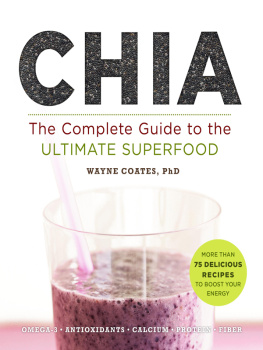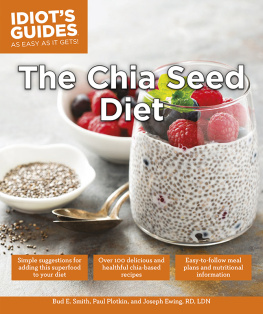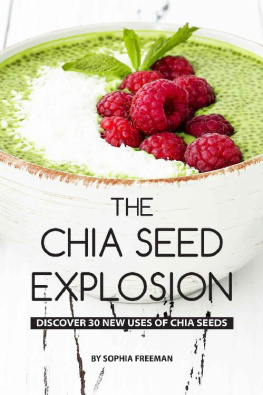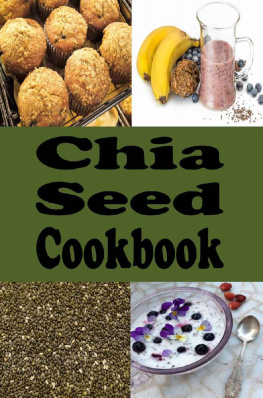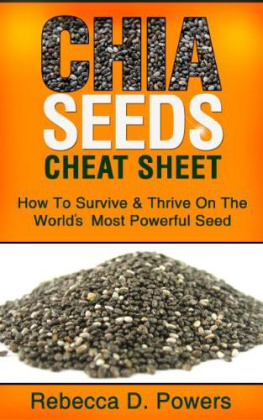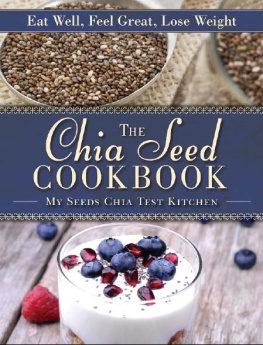Also by Wayne Coates, PhD
Chia: Rediscovering a Forgotten Crop of the Aztecs
Also by Stephanie Pedersen
DK Natural Care Library
KISS Guide to Beauty
Chia
The Complete Guide to the
ULTIMATE SUPERFOOD
WAYNE COATES, PhD
withSTEPHANIE PEDERSEN


STERLING and the distinctive Sterling logo are registered trademarks of Sterling Publishing Co., Inc.
2012 by Wayne Coates, PhD
Interior design by Allison Meierding
All rights reserved. No part of this publication may be reproduced, stored in a retrieval system, or transmitted, in any form or by any means, electronic, mechanical, photocopying, recording, or otherwise, without prior written permission from the publisher.
ISBN 978-1-4027-9943-3 (paperback)
ISBN 978-1-4027-9944-0 (ebook)
For information about custom editions, special sales, and premium and corporate purchases, please contact Sterling Special Sales at 800-805-5489 or specialsales@sterlingpublishing.com.
2 4 6 8 10 9 7 5 3 1
www.sterlingpublishing.com
PRODUCED BY
AUTHORSCAPE INC.
O ne day in 1984, I left my desk to go for a run. It was noon, and not only did I want some exercise, I wanted to get myself out of the office. That was the beginning of my new, healthier way of life. As the years rolled on, I began running more often and at greater distances, until in 2000 I decidedfor some unknown reasonto enter the Tucson Marathon. I ran that race and loved every minute of it. From that time on, some might say, my love of running got out of hand.
Which, I suppose, is where chia comes in.
Today, I regularly run 5Ks, 10Ks, half-marathons, marathons, ultra-marathons, and even 100-mile runs. Before the longer events I tuck film canisters filled with chia seed into my running belt. During the run itself, I dump about half the contents of a canister into my mouth, and then wash it down with a swig of water.
Chia is extremely digestible and soothing to the stomach (not to mention joints!). It helps with stomach issues, slows digestion, increases overall hydration, helps maintain electrolyte balance, and improves stamina during these extended runs. During these ultra-distance runs, some of which have taken me up to 32 hours to complete, you go through terrible mood swings, when you start wondering what you are doing. I found that chia helps lessen these gloomy feelings.
Im not the only marathoner whos in love with chia: Many runners consume chia regularly, thanks to the success of the book Born to Run, by extreme runner Christopher McDougall. This national bestseller follows McDougall as he seeks out the worlds most elite ultra-distance runners in order to learn their secrets. His quest takes him to Mexicos brutal, isolated Copper Canyon, home of the reclusive Tarahumara Indians. MacDougall learns their techniques and the secrets that allow them to run hundreds of miles without fatigue. Although I have not run with them, I have visited the area several times and run on their trails. The scenery is great, but the running is tough!
Having run both with chia and without, I now know why athletes love it so much. Chia gives you an amazing amount of energy and increases endurance to unbelievable levels. In fact, whenever I talk to athletes who use chia, they always comment on gaining more energy in the later stages of their runs. They also mention an overall increase in energy, especially later in the daya time when many people grow fatigued and sluggish, and rely on caffeine and sugar for quick and unhealthy pick-me-ups.
Chia came into my own life by accident, really. I first came across this tiny seed in 1991 as an agricultural engineer. I was part of a team from The University of Arizona that visited South America in order to research alternative crops that might grow well in northwestern Argentina. Working directly with the growers, we planted a number of different seeds to determine which might perform the best. One of these was the ancient Aztec food, chia.
Ill admit that when my fellow researchers and I first saw the maturing seed, our initial reaction was, What the heck is this stuff good for? To find out, we began analyzing the seed to determine its various nutrient compounds, such as fiber. In the field, we saw that if it had rained, the seed would form a gel and stick together. This showed us that chia seed was great both as a hydrating compound and for retaining moisture.
Researching the nutrient profile of the plant, we discovered that chia seed contains an incredible amount of omega-3 fatty acids4 grams per 2-tablespoon serving. In fact, chia has more omega-3 fatty acids and, in particular, alpha-linolenic fatty acidthe only essential omega-3 fatty acidthan any other known plant.
This was a hugely important discovery because medical research shows that omega-3 fatty acids reduce inflammation in the body and help lower the risk of chronic diseases such as heart disease, cancer, and arthritis. Omega-3 fatty acids are important for everyday cognitive function (such as memory and performance), as well as creating stable moods and helping to regulate behaviors. Many Americans show symptoms of omega-3 fatty acid deficiency, which include fatigue, poor memory, dry skin, heart problems, mood swings or depression, and poor circulation.
We also discovered that chia boasts impressive amounts of antioxidants, including the phytonutrients quercetin, kaempferol, myricetin, chlorogenic acid, and caffeic acid. These antioxidants have significant value to human health, helping ward off everything from cancer to common viral illnesses. But what I found really exciting about these high levels of antioxidants is that they keep chia fresh and prevent rancidity.
Unlike highly perishable flaxwhich has an indigestible hard coating that keeps its nutrients freshchias antioxidant profile allows it to remain shelf-stable for years. No hard shell means chia can be eaten and digested fully as-is. Because chia doesnt become rancid at room temperature, you can pulverize it as much as you like ahead of time, to use at your convenience. Also, chia doesnt have the slightly fishy taste that flax tends to develop shortly after grinding. These are three more reasons why my fellow researchers and I were so excited about chia.
But still the question remained, What do we do with this seed? Our first thought was skincarethe high omega-3 and antioxidant content make the oil from chia great for the skin. We also began feeding the seed to chickens and cows to create eggs and dairy products high in omega-3s. Beginning in the 1990s, producers began feeding animals flax, marine algae, and even fish derivatives to increase the omega-3 fatty acid content in eggs and dairy. Unfortunately, the enhanced products were left with an off-putting, fishy flavor that arose from the oxidation of the omega-3 fatty acids in the flax.
Our own research showed that chia did just what we wantedincrease the omega-3 content without altering the natural taste of eggs and milk. The amount of omega-3 fatty acids in the yolks of eggs laid by chia-fed hens increased by more than 1,600 percent, while the saturated fat content decreased by 30 percent. In a limited trial, in which chia was fed to milk cows, the milk had a 20 percent increase in omega-3 fatty acid content and a reduced saturated fatty acid content.

A member of the mint family, Salvia hispanica
Next page
